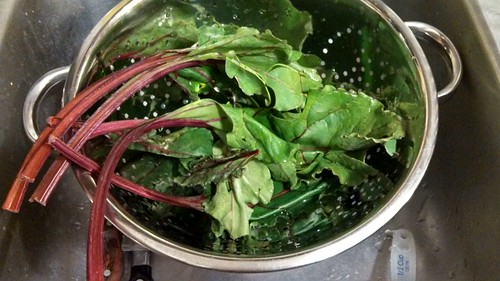I love making lasagna. If I could make only one dish to sum up the kinds of food I love to cook, lasagna would probably be it. I think that's why this dish spoke to me. It added my favorite winter squash, with my favorite starch (interesting enough in my favorite color, which is usual for it), with a new green that I have always wanted to try. All in my favorite sauce and cheese of course.
Lasagna is not an easy dish. Nor is it one for the impatient. Still, this delightful little number was perfect for our winter celebration.
Winter Vegetable Lasagna
Inspired by Frenchtown Community Garden
[What you need]
1 butternut squash
1 bunch swiss chard
3-5 blue potatoes (amount depends on size of potato. You also don't have to use blue, but they're pretty and very good for you!)
1/2 lb chorizo or Italian sausage
lasagna noodles
tomato sauce
~8 oz ricotta cheese
~8 oz mozzarella cheese
sage to taste
[What to do]
[I find that I am slowly turning into my bisnonna as I write this recipes. I have a tendency to want to give you a list of ingredients and say "now go for it!". I'm resisting, of course.]
1 bunch swiss chard
3-5 blue potatoes (amount depends on size of potato. You also don't have to use blue, but they're pretty and very good for you!)
1/2 lb chorizo or Italian sausage
lasagna noodles
tomato sauce
~8 oz ricotta cheese
~8 oz mozzarella cheese
sage to taste
[What to do]
- Cube squash and potatoes; Devein the chard and cut into strips.
- Precook veggies and meat. I sauteed the chard, boiled the squash and potatoes in the microwave, and browned the meat on the stove. I'm certain your choice method will work just as well here.
- Combine the veggies, meat, and a generous helping of sage.
- Grease a 9x13 pan (Lasagna sticks. My sister buys disposable pans to make her lasagna it can get that bad.), arrange the noodles and layer tomato sauce, both cheeses, and filling mix.
- Repeat until you have reached the top of your pan. Add one final open layer to the top. It looks pretty that way.
- Cover and bake at 350*F for 50-60 minutes
[I find that I am slowly turning into my bisnonna as I write this recipes. I have a tendency to want to give you a list of ingredients and say "now go for it!". I'm resisting, of course.]

